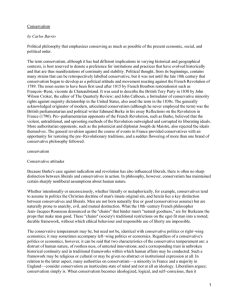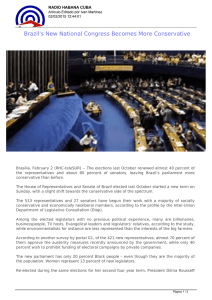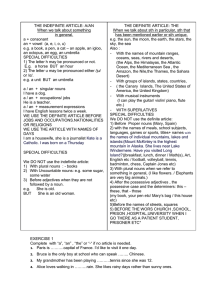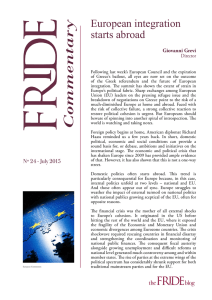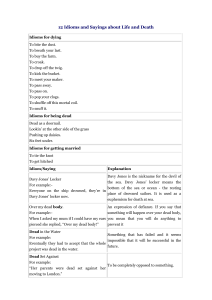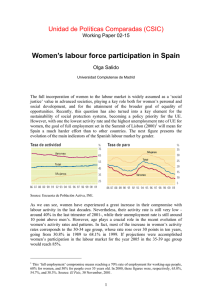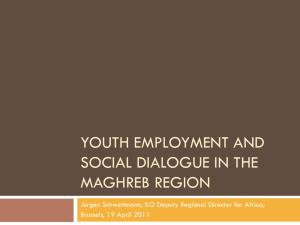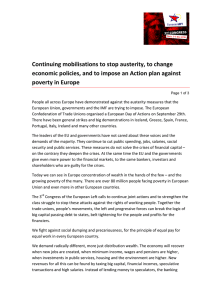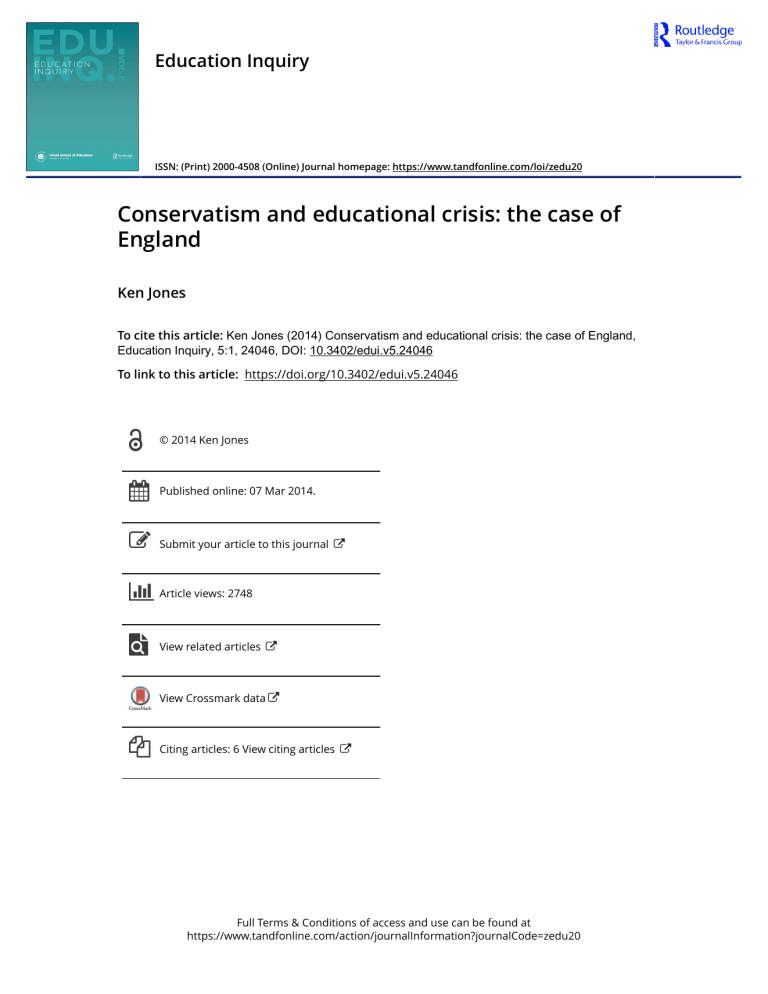
Education Inquiry ISSN: (Print) 2000-4508 (Online) Journal homepage: https://www.tandfonline.com/loi/zedu20 Conservatism and educational crisis: the case of England Ken Jones To cite this article: Ken Jones (2014) Conservatism and educational crisis: the case of England, Education Inquiry, 5:1, 24046, DOI: 10.3402/edui.v5.24046 To link to this article: https://doi.org/10.3402/edui.v5.24046 © 2014 Ken Jones Published online: 07 Mar 2014. Submit your article to this journal Article views: 2748 View related articles View Crossmark data Citing articles: 6 View citing articles Full Terms & Conditions of access and use can be found at https://www.tandfonline.com/action/journalInformation?journalCode=zedu20 Education Inquiry Vol. 5, No. 1, March 2014, pp. 89108 Conservatism and educational crisis: the case of England Ken Jones* Abstract The Conservative-led Coalition government in Britain is strongly committed to a programme of austerity. In the short term, this is a programme which makes more difficult the country’s exit from a period of recession and slow growth; in the longer term, it threatens cuts and privatisation which call into question the welfare state. Yet, politically, the Coalition has managed the post-2008 crisis more effectively than other European governments. Focusing on education, where the government’s right-wing radicalism is strongly evident, this article explores possible reasons for its political success. It looks particularly at the Coalition’s policies for teachers, and for the extension of private influence over schooling, as well as at the way it justifies its policies with reference to a reconceptualisation of ‘equal opportunity’. It suggests that these are the culmination of more than 40 years of discursive elaboration and programme-building, which have weakened opposition to a point which makes the immediate costs of policy implementation quite low. It suggests, however, that the Conservative achievement is an unstable one, more likely to sharpen long-term political and social tensions than to resolve them. Keywords: Conservatism, privatisation, crisis, equal opportunity, education politics Five years after the financial crisis of 2008, its consequences have taken varied and distinctive shapes across Europe. No country is free from the effects of the recession that the crisis triggered, but there is a marked divergence between countries of the south especially Greece, Italy, Portugal and Spain and most of those in central and northern Europe. The modest growth rates of the north are in stark contrast to the deep and lasting depression that has gripped the southern part of the Eurozone, where unemployment rates, especially among youth, have long since reached crisis point, and where real wage levels have fallen steeply (Euromemo Group 2013). In the south, loans to countries with otherwise unsustainable levels of interest repayment on their deficits are dependent on programmes of fiscal austerity and structural reform, including privatisation. This is the programme that the European Commission, the European Central Bank and the IMF the new troika at the heart of European governance work to impose on national states, through memoranda of understanding that are detailed and explicit in their requirements for cuts in social spending, state reconfiguration, and reduction in the cost of labour. (e.g. European Commission 2011). *Goldsmiths, University of London, UK. Email: ken.jones@gold.ac.uk #Authors. ISSN 2000-4508, pp. 89 108 Education Inquiry (EDUI) 2014. # 2014 Ken Jones. This is an Open Access article distributed under the terms of the Creative Commons CC-BY 4.0 License (http://creativecommons.org/licenses/by/4.0/), allowing third parties to copy and redistribute the material in any medium or format and to remix, transform, and build upon the material for any purpose, even commercially, provided the original work is properly cited and states its license. Citation: Education Inquiry (EDUI) 2014, 5, 24046, http://dx.doi.org/10.3402/edui.v5.24046 89 Ken Jones The pacts between transnational institutions and national political classes willing to carry out their programme have had the effect of cancelling the gains won in the period since the fall of authoritarian regimes in the 1970s. They call into question issues of national sovereignty, and provoke angry responses on the part of large sections of the population. They have thus contributed to a delegitimation of mainstream political parties, and to the emergence of Syriza in Greece, the Bloco de Esquerda in Portugal and of popular movements like the indignados in Spain. The electoral eclipse of the pro-EU Monti government in Italy, and the sudden emergence in late 2013 of the populist forconi movement is part of a similar process. A partial exception to the north/south divide is Britain. Compared with Scandinavian countries, the Netherlands, Germany and Austria it has pursued a relentless policy of austerity in the face of economic indicators that continue to relay a feedback message that goes unregarded: attempts to shrink the country’s financial deficit, through tax rises and spending cuts, have prolonged the recession and created only weak prospects for growth1. This policy, the hallmark of the Conservative-Liberal government that has been in office since 2010, is locally generated. Britain has had no need of a troika to enforce a programme of austerity: it has a government as committed to the flexibilisation of labour and the shrinking of the welfare state as any ‘troikist’ might want (Chowdry and Sibieta 2011). Two bite-sized statistics suggest the scope of ambitions: in December 2013, the ‘Office for Budget Responsibility’ declared that ‘by 2018, general government consumption will be proportionally no larger [in terms of share of GDP] than it was in 1948’ (Hutton 2013); in the same month, analysis of publications from the National Audit Office suggested that 50% of the government spending is contracted out to private sector companies (Wilks 2013). The state shrinks, and at the same time the extent to which privatisation becomes the mode of provision of state services increases. The programme is presented not so much as something foisted on an unwilling nation by external agencies, than as what John Clarke and Janet Newman have called a ‘virtuous necessity’ (2012: 304). The Coalition claims both that ‘austerity is necessary, and that its adoption represents an act of political virtue (by contrast with the UK opposition and eurozone countries)’ (ibid). It is not just a short-term exigency but a programme that ‘can accomplish a long-needed restructuring of economy and society, and create at the same time a spirit of national unity (op cit: 305). In this sense, austerity is future orientated: in the words of Prime Minister Cameron, ‘we will get through this together and Britain will come out stronger on the other side’ (Cameron, 2010: 5). In political terms, the Coalition has been more successful than the austerity governments of southern Europe. The opposition Labour Party has largely accepted the case for cuts and state restructuring. No new political force has emerged to express popular discontent. Trade unions, a few demonstrations of protest aside, have not posed a threat. Apart from the student campaign of 2010 against a rise in 90 Conservatism and educational crisis the level of tuition fees, and the spectacular summer riots of 2011, the Coalition has not been opposed with any degree of ferocity. In the space thus allowed it, the Coalition has been able to devise a narrative in which the cause of the crisis is presented as government over-spending, and a large part of the solution involves cuts to public spending, most explicitly on social security. The public sector is presented as a drain on resources, the private sector as wealth creating. ‘Shirkers’, the unemployed work-shy, are contrasted with ‘strivers’, those who are looking to build careers and buy a home (Osborne 2012). Whether or not the Conservative Party, the leading force in the Coalition, emerges from the next election with the most parliamentary seats, it has already established the course of English politics and political debate for the next decade. Labour, fearful of being seen as the ‘welfare party’ (Ross 2013), is committed to maintaining the Coalition’s fiscal policies. The so-far successful exploitation of recession as an opportunity for a politics of austerity prompts memories of an earlier Conservative government, which also came to office presenting itself as the answer to a situation of emergency, and whose strategy of exit from recession involved measures similar to those which are now being adopted. This, of course, was the Thatcher government of 1979, whose rhetoric, political stand, short-term economic responses and long-term vision are echoed in much of the Coalition’s perspective. The long Conservative revolution, begun by Thatcherism, has resumed, in both ideological and economic forms. This is a situation the reasons for which are not prima facie clear. The negative achievements of Conservatism in and after the Thatcher period are evident. It laid the basis for rising income inequality; it presided over a process of de-industrialisation that was not offset by growth in new manufacturing sectors; its privatisation programme greatly increased the cost to consumers of public utilities. It exacerbated regional inequalities, and in the process strengthened the movement for Scottish independence. It has seen its share of the UK vote decline to levels unmatched since the Party took shape in the nineteenth century. How can a party with such a chequered record of achievement have attained a position of hegemony, in terms of establishing the pathway which has guided economic development and social change in Britain for 40 years? There are two main answers to this question. The first has to do with the Conservatives’ role in resolving the major political struggles of twentieth century Britain. Corey Robin, quoting the nineteenth century Prime Minister, Lord Salisbury, reminds us that ‘hostility to radicalism, incessant, implacable hostility, is the essential definition of Conservatism’ (Robin 2011: 19). Such hostility was at the core of Thatcher’s political identity: if the post-war settlement and the working-class militancy of the 1970s were a ‘revolution’, then she was a counter-revolutionary. The governments she led in the 1980s conclusively defeated their main opponents, the industrial trade unions, first through victory against striking steelworkers, dockers 91 Ken Jones and miners, and then through a de-industrialisation that removed the material basis for the unions’ existence. In the same period, they benefited from a split in the Labour Party which handed the elections of 1983 and 1987 to Thatcher, and thus enabled the legislative programme of privatisation and welfare reform that shaped the following decades. These measures, adopted at a time when oppositional forces had been dispersed, helped create a new socio-economic world, of heightened responsiveness on the part of every social institution to what were presented as the requirements of the economy: in Foucault’s terms, social action became marketshaped (Lemke 2001: 197), and the market in question was one in which the constraints on Capital imposed in the immediate post-war decades had been removed. The pattern of market-related action referred to by Foucault became the basis of a new common sense, often expressed by Thatcher in the phrase ‘there is no alternative’. The second answer is more explicitly ideological. Thatcherism was, as Stuart Hall insisted, an ideological formation (Hall 1988). It understood the centrality of economics, evidently, but as Thatcher herself put it, the ulterior purpose of economic reorganisation was to ‘change the soul’ (Gray 2010). Conservatism in this period aimed to suffuse everyday life with its descriptions, critiques and solutions; its economic policy did not just offer technical means of crisis resolution, but was embedded in an ethic that championed individual responsibility against welfarism. It saw social expenditure as at best a regrettable necessity, and at its more usual worst, as a restraint on wealth creation and the human capacity for resourcefulness and inventiveness. In their efforts to link ethics and economics, Thatcher’s governments owed a great deal to the revival of economic liberalism under the auspices of Hayek and his co-thinkers (Stedman Jones 2012). The think tanks of the 70s and 80s the Institute for Economic Affairs, the Adam Smith Institute, the Centre for Policy Studies and others worked on a repertoire that gave concrete shape to Hayekian ideas. Translated into policy recommendations, and ceaselessly elaborated as ways of understanding the crisis of the welfare state and the means of exiting it, such thinking came to define the horizon of what was politically possible. The idea of post-war Keynesianism, that economic intervention should aim at achieving full employment and securing social welfare, migrated towards the margins of politics (Lapavitsas 2012). It needs to be added that Thatcherism incorporated other energies than the drive for economic change (Levitas 1986, Hall 1988, Gamble 1988). Beyond the ethics of economic life, Conservatives drew on another set of ideological resources, emotive, powerful, if sometimes contradictory. Burkean themes of allegiance to a sovereign national power and a traditional way of life (Scruton 1980) were in some senses at odds with the globalising of social relations and the dismantling of nation-centred institutions that were necessitated by neo-liberalism. Nevertheless, these themes supplied Conservatism with a vital point of reference. Appeals to a tradition 92 Conservatism and educational crisis threatened by a relativistic, multi-cultural leftism formed an important part of Conservative cultural politics. They supplied Conservatism with much of its polemical verve; they inspired the party’s militants; they enabled it to attract groups of intellectuals, who elaborated the critique in relation to particular sectors notably education; they allowed Conservatism to claim the high ground of public debate, speaking to popular insecurities; they spoke a vigorous language of change, while promising a future that resembled a fondly-remembered past. It is against the background of this historical record, and the economic transformation, political victories and cultural offensives that are embedded within it, that we can begin to understand the current success of the Coalition government in implementing its programme of austerity. The Coalition is politically and ideologically successful because the earlier achievements of Conservatism consisted precisely of destroying or weakening forces that might otherwise have contested the politics of recession; and because it can draw from a repertoire of discourses and actions that make sense in terms of the neo-liberal orthodoxies that have set the terms of policy-making over a long period. It is within such a context, of the overall success of Conservatism as a political project in England, that I now go on to consider its educational programme, both as it developed in the original period of Thatcherism - and Thatcherism’s precursors - and as it is now deployed in response to economic and social crisis. The presentation is in two parts, the first largely historical, the second focused on the present moment2. Conservatism and Education in England The 1944 Education Act established the fundamental condition for educational modernisation, in the form of mass secondary education. In the seventy years since then, Conservative education politics have developed in three significant stages. The first, in the late sixties and 1970s, transformed Conservatism in education from a force identified with the defence of educational privilege, to one possessing a programme that could be presented in more popular terms. The second, marked by the Education Reform Act of 1988, institutionalised that programme, giving modernisation a marketised shape. The third stage, through which we are now living, radically extends the programme of 1988, in the direction of further privatisation, and the elimination of countervailing political influences, whether based in elected local authorities, educational trade unions or universities. It is the cumulative effect of these successive policy developments, with the earlier stages providing the grounds for the success of later policies that has made the Conservative educational programme a powerful political force. In this sense, the past is very much a living force that shapes the politics of the present. The Second World War was a troubling experience for British Conservatism. Though its response to Nazism had been much less compromised than that of other European parties of the right, the Party feared that the course of the war the Soviet 93 Ken Jones alliance, the armed popular resistance to fascism in Europe had encouraged demands for social transformation to the point where they could no longer be contained within a paternalist agenda of limited reform, that allowed the social order to be kept in place. Many conservatives expressed this fear in catastrophic terms: the war would bring about the overthrow of traditional social hierarchies and the education in loyalty and deference that had sustained conservative rule. ‘I dreamed that life was over’, Winston Churchill told his physician in 1945 after the landslide defeat of his party in the elections of that year (Lavery 2007: 362). This perception of irrecoverable decline was commonplace on the right, and supplied the basis of its understanding of cultural change. For the novelist Evelyn Waugh, wartime had seen the rise of the common people, in all their rancour and resentment against the educated, the civilised, the graceful, the honourable (Waugh 1955). In his influential Notes Towards a Definition of Culture, T.S. Eliot expressed a similar view: mass civilisation was incompatible with cultural value (Eliot 1948). The counterpart of this nostalgia for the sweetness of life before the revolution was a scepticism well expressed by the conservative philosopher Michael Oakeshott about all programmes for systematic change; because they involved planning, regulation, state intervention they were ipso facto to be mistrusted (Oakeshott 1962/ 1991). The Conservative governments of 195164, like others in Western Europe, adopted policies of educational expansion. To do so, they had sometimes to over-ride opposition from their own supporters, who were opposed to ‘excessive’ state spending (Woodin et al. 2013). Moreover, as Gamble (1974) has noted, the grassroots of the Conservative Party retained an Oakeshottian dislike for structural reform in education, an attitude which was chanelled into defence of the grammar school, the academic element in the tripartite secondary system established after 1944. Local campaigns and national Conservative policies converged on this one point; the grammar school must be preserved, against attempts to create local, comprehensive systems of secondary schooling. The problem for Conservatives was that their position involved both a defence of minority privilege and a lack of responsiveness to what were widely held to be policy imperatives. Expansion and further modernisation, beyond the limits of 1944, were seen as essential means of tapping the resources of mass intelligence that the grammar school neglected. Temperamentally disposed towards a defence of tradition they felt was in decline, and programmatically committed to a minority interest, Conservatives lacked a point of view from which to intervene productively in educational politics. Towards the end of the 1960s, Conservatism began to take a course that led it out of this impasse. Opposed to progressivism and comprehensive education, alarmed at the events of 1968 and their repercussions across Europe, a group of academics, literary figures and dissident educationalists, produced in 1969 the first in a series of ‘Black Papers’ on education (Cox and Dyson 1969a, 1969b). Their articles expressed 94 Conservatism and educational crisis a dissent from the policies of the Labour Party, for which many of them had voted up until the election of 1964, and signalled their transition towards Conservatism, whose policies and cultural principles they embraced in the 1970s. Their target was the hesitant, piecemeal and never-to-be-completed reform of schooling, associated with the progressive moment of the 1960s a moment when the official Plowden Report, Children and their Primary Schools, had endorsed progressive educational principles as a basis for primary education, and when the Labour government of 19641970 had encouraged local schemes of comprehensive secondary reform. They criticised the progressive curriculum for its undermining of intellectual tradition, and its pedagogy for problematising the authority of the teacher. Reform, they argued, was taking a course that led away from ‘standards’ and the disciplined educational order that was their precondition; it was therefore betraying those who most needed the support of the school: working-class children (Cox 1992). Reform’s proponents teachers and university-based educators were irresponsible enemies of what was life-enhancing and socially empowering in education. They destroyed the very system that had enabled their own success. The claims that Black Paper contributors made about a decline in standards of literacy and numeracy have been tested and criticised many times (Wright 1977, Simon 1991). In this sense, the case against them was strongly made. But their achievement was less dependent on their truth than on their rhetoric and political effect. They supplied a discursive repertoire of which conservatism, ever since, has made good use, blending a nostalgia for an educational past represented as orderly and successful, with a critique of a present that was framed in populist rather than élitist terms. Yet the essence of the conservatism of Eliot and Waugh was retained. Cultural and educational excellence was associated with selectivity and restriction: the bright ‘working-class schoolboy’ would benefit from the grammar school, or a grammar school type of education (Amis and Conquest 1969: 155), but the mass university was a contradiction in terms (Boyson and Cox 1977). In addition to providing right-wing educational politics with a powerful content, the Black Papers also gave it an effective form. Corey Robin (2010) has suggested that conservatism is characterised less by a quiet reverence for a diminishing past he regards Oakeshott’s version of Conservatism as a ‘conceit’ not an insight - than by a ‘wildness’ which evokes sedate visions of the past only to justify a sweeping and turbulent programme for the overthrow of those welfare-Keynesian settlements which followed the Second World War. The Black Papers in this sense were typical of conservatism. Their wildness in the form of exaggerated claims whose evidence base was slight, of a rejection of consensual norms, and a view of opponents as traitors to educational and cultural tradition (Norman 1977, Cox, Jacka et al. 1977) was a means of shaking public confidence and media toleration of the reforms of the sixties. It presented the real difficulties of developing a new kind of schooling in the 95 Ken Jones worst possible light, as a project doomed to fail, and sustained only by the foolish persistence of those in the educational establishment who were committed to it. As they evolved, between 1969 and the year of their fifth and final issue, in 1977, the Black Papers shifted position, beyond a stage of critical reaction, to one in which derision was combined with the beginnings of an alternative programme for educational change, voiced by contributors close to Conservative Party thinking. (Sexton 1977). The alternative took the form of the combination of a state-regulated national curriculum, and an institutional system based on school autonomy and parental choice. It was a programme for radical, systematic reconstruction, in which market principles were linked to conservative notions of educational value: the autonomous school would provide a home for the traditional educational virtues of an academic curriculum, the most successful of such schools would consolidate the values that comprehensivisation had threatened. In this way, the Black Papers developed beyond the self-limiting, antiprogrammatic principles of Oakeshottian conservatism, and helped set in motion a far-reaching programme of state-driven change. Yet implanted within a new institutional model were ideals that stemmed from a conservative past that the Black Papers wished to rescue. Throughout the various iterations of the Conservative education programme since 1977, these ideals have acted as what Anderson has called an ‘ideological supplement’. The ‘pure doctrine of the free market that is the animating spirit of neo-liberalism is, by itself,’ he writes, ‘too arid and abstract a creed to offer satisfying fare for any mass electorate’ (Anderson 2001: 7). Parties of the right require a further affective resource; for Conservatives in education, it is supplied by the vision of a recaptured past, of an order in which the justice of hierarchy is recognised across a whole culture. Although, the Black Papers ceased publication in 1977, the educational right did not; the volume and diversity of its publications increased over the next decade, and to read its output is to be struck by a sense of a movement on the rise, possessing an inventive capacity to devise and disseminate analyses and policy proposals. Its preferred mode of presentation, though, had less to do with construction than with critique. Teachers, schools and local authorities which sought to develop policies related to objectives of equality (Arnot 1991) were ‘exposed’, both by campaigners of the right, and by the television and newspaper journalism they inspired (Jones 1989). By contrast, voices in support of equality-oriented reform were muted; although their base in the world of education was stronger than in previous post-war decades, their ability to attract public support was not; they lacked fluency in the kind of public affective language that the right was adept in. The Labour Party, which could have acted as a force that popularised curriculum reform and pedagogic change, regarded the whole topic as an area of political vulnerability, with the result that the popular hegemony of the right was not challenged. The distance between Labour and progressive reform has never since been closed. 96 Conservatism and educational crisis The culmination of the right’s work was the Education Reform Act of 1988 (ERA). Through the ERA, Conservatism moved from critique to construction. Construction took the form sketched in the Black Paper of 1977: a national system of curriculum and assessment, and an institutional framework based on school autonomy and central oversight of assessment results. The ERA was accompanied by legislation that ended a ten-year period of teacher militancy. After a powerful initial response to some of the ERA’s measures (local votes against the introduction of grant maintained schools, outside the local authority system; a teachers’ boycott of the testing system in 1993 and 1994) the world of education settled into the pattern established in 1988. The practices of schooling became market-shaped; success and failure were measured in terms of exam results, and the rise in school status that they enabled; micro-inspection of schools by the Ofsted, the Office for Standards in Education set up in 1992, complemented the discipline of the market; target-driven management, in this system of inter-school competition, became the norm, and deeply affected the cultures of school work (Hextall and Mahony 2000). As the space of education became defined and constrained in these ways, so the possibility of alternative forms of thinking and practice was driven to the margins in other words towards research and reflection in the context of university departments of education. A gulf developed between the work of schools and the positions of researchers and teacher educators. Academic work, unless tied to an effectiveness and improvement agenda, became less central to educational practice than in the pre-1988 period. The 18-year period of Conservative government ended in 1997. The Labour government that succeeded it differed significantly, notably in its commitment to increased educational spending some of which was targeted, in the name of social inclusion, on working-class learners, especially at under-five and post-16 levels (Chowdry and Sibieta 2011). It also tempered the ethnocentric emphases of the right, and encouraged to some extent the development of a ‘creativity’ agenda, justified in terms of new kinds of labour market demand (Buckingham and Jones 2001). In this sense, the cultural themes of Conservative educational ideology receded. In other respects, Labour accepted and endorsed the Conservative legacy, especially its institutional and systemic reforms. The setting of targets for school performance was further refined. The results of school inspection became an existential matter for schools failure entailed being placed under permanent surveillance, with the strong possibility of closure. Privatisation of provision and influence were both encouraged. By 2006 ‘the share of schools’ expenditure involving the private sector’ was round 30% (CBI 2005: 8). From 2002, Labour’s Academies programme construed school improvement as a process that could best be managed through private sector involvement in the running of schools. As Ball has shown, the influence of the private sector especially the finance sector at every level of policy-making, initiative and practice increased considerably (Ball 2007). 97 Ken Jones Michael Gove Michael Gove, Secretary of State for Education since 2010, is often regarded by political commentators as an exceptional minister, on at least two grounds. The first is that his policies are ideologically driven, to an extent that is unusual among political leaders. The second is that they are pursued with great speed and directness (Brogan 2013; Young 2013). Thus Toby Young reports admiringly: ‘[Gove] likes to joke about overseeing a ‘permanent revolution’, but for defenders of the status quo in what Gove refers to as ‘the Blob’ (the educational establishment), the scale and pace of his reforms is no laughing matter. He urged David Cameron to push through an education bill (prepared in secret before the election) in his first 90 days as Prime Minister . . . thereby denying the teaching unions an opportunity to organise. It was done in 77 days. That Act of Parliament enabled a majority of England’s state secondary schools to convert to ‘academy’ status, making them operationally independent and free from local authority control. It’s a change so far-reaching that the political opponents of academies are still reeling in shock and awe’ (Young 2013). This is, in some senses, an exceptional achievement. Other legislation in the same period, such as the Health and Social Care Act, which sought to extend privatisation in the National Health Service, encountered opposition that was much more difficult to overcome (Davis and Tallis 2013). By contrast, Gove has generally been successful in translating into legislation policies that dismay educationalists at the same time as they resonate strongly with Conservative activists policy-making without consensus. However, in a more general sense, Gove appears less the exception than the rule. Educational politics since the 1970s have been a breeding ground for Conservatism activists of a particular sort strongly committed ideologically, deeply opposed to dialogue with educational interests, traditionalist in their conception of teaching and learning, market-focused in their policy innovations (see Jones 1989, Exley and Ball 2010). Gove’s many speeches and articles repeat the cadences, vocabulary and preoccupations of earlier generations. He is likewise indebted to these generations for the educational landscape he inherited. Even if it had been recoloured by concerns for social inclusion, its contours had been ordered for more than two decades according to an original Conservative plan. Moreover, the balance of power in educational policy-making allowed him great scope for initiative. Labour continued to think within the parameters of neo-liberal orthodoxy. Local authorities had lost political authority as well as control over day-to-day policy. A generation of teachers had grown up knowing only the procedures and objectives of the post-1988 system. Parents and students, in social conditions of ever-greater insecurity, were focused on issues of school choice and examination success. Thus, in addition to the overall advantages possessed by the Conservative politics of austerity, there were factors specific to education that provided favourable conditions for right-wing initiative. Gove’s exceptionality lay in the dexterity with which he exploited this initiative. 98 Conservatism and educational crisis Liberated by the Coalition government’s presentation of itself as an emergency regime, that would use forceful measures to exit from an epochal crisis, Gove seized his opportunity, which he understood in both destructive and creative terms. Destructively, Gove concluded that, more than 25 years after the ERA, which was supposed to settle such matters, there was still something to be done to break the connection between the school and the aspirations towards democracy and equality voiced in the later twentieth century. Creatively, he aimed to extend, in new conditions of possibility, the achievements of the Thatcher period, so that schooling was reinvigorated by competitive mechanisms and private sector influence. In both aspects of his programme, Gove revived the rhetoric and the political tactics the rapid war of manoeuvre that characterised Conservatism in the late twentieth century. The social complex of education The nature of this destructive-creative programme, as well as the range of its ambitions, both institutional and discursive, can best be grasped by thematising it, under three main headings. The first of these concerns what Gramsci termed the ‘social complex’ of relationships through which educational programmes are elaborated and realised (Gramsci 1971: 36) a relationship to which teachers and educationalists are central; the second relates to the reconstruction of the school system along more thoroughly marketised lines; the third to Gove’s reinterpretation of ‘equal opportunity’ and his attempt to recuperate the term within a discourse of the right. Teachers and university-based teacher educators had been a central target of the polemics of the Black Papers and the think tanks which followed. In part, the emphasis of their attacks was ideological. It focused on the educational beliefs that sustained a damaging educational practice. Educational theory, developed in the famous ivory tower of academe, had come to emphasise the process of learning rather than its outcomes. It encouraged an education remote from the needs of the labour market. Its insistence that educational achievement was limited by social situations outside the school lowered expectations of students, while leading education policy in ever more radical directions, towards broader agenda of social reform. This ideological drift had to be stopped. As the thinking of the new right came increasingly to be affected by Hayekian ideas, the critique had become more fundamental, extending from wrong-headed beliefs to the structural position of teachers. It was claimed to be in the nature of any public sector workplace, insulated from the market-based discipline of accountability through competition, that it would be captured by those who worked in it. In the words of the Adam Smith Institute: ‘However dedicated they may be as educators . . . the cocoon of producer interest keeps spinning round them. Their working environment wears each one down until they firmly 99 Ken Jones accept that teachers deserve more money . . . need smaller classes, cannot teach properly without a degree, should not be judged by their exam results, should have a guaranteed job for life and so on’ (ASI 1984: 2) Unions were seen as organisations that defended these sectoral interests; They prevented the school from refreshing its capacities through discovering and meeting new kinds of public demand. The Teachers’ Pay and Conditions Act and the apparatus of curriculum and testing introduced after 1988 had worked to diminish these influences. So had the setting up of the Teacher Training Agency in 1994, which reduced universities’ influence over teacher education, at the same time as they were subjected to the chastening effects of inspection by Ofsted. Nevertheless, in 2010, teachers remained relatively strongly unionised (European Foundation 2011), even if union activity was at a much less intense level than in the 1980s (Edwards 2008); university departments of education continued to elaborate research perspectives that were distant from, and often sceptical of, government priorities. Gove addressed these difficulties. Though the Labour government had made incremental salary progression conditional upon successful passage through a threshold assessment, it had left intact the national pay structure, which set out a pattern of incremental progression that all teachers, would follow. Gove regarded this structure as a collectivist relic. He proposed that individual school managements should be able to set differential pay levels for each teacher, and that, in the case of some categories of schools, should be able to recruit unqualified teachers (Stevenson 2013). This would have several linked effects on teachers. The recruitment of unqualified staff would downgrade the status of educational knowledge: teachers would be employed for their subject expertise; as for ‘the rest’ pedagogy, for instance this could be picked up on the job. The further reduction in the importance of the pay structure would tend to reduce whatever element of individual professional autonomy teachers still possessed, as well as reducing the element of common ground between teachers in a school; de-collectivisation of the workforce would make it a more effective instrument for the transmission of official educational agenda. In these ways, flexibilisation, for which Cameron’s government was pressing, across all sectors, was translated into educational terms, while at the same time the historic complaints of Conservatism about teacher professionalism found new answers. Measures affecting the management of teachers were complemented by others that aimed to reshape their training (Menter 2013). Following the 2010 White Paper, The Importance of Teaching, Gove further shifted towards schools the responsibility for initial teacher education. This called into question the viability of university departments of education, whose income would greatly be reduced by such a shift. Beyond questions of finance, the sidelining of universities would have a further 100 Conservatism and educational crisis welcome effect. School-led training would focus the education of teachers specifically on the tasks necessary to secure effective education in terms of the performancedriven system under which schools were required to work. Like changes to the salary system, it was a long-term measure, intended to close of possibilities for the development of counter-systemic influences. Academies and Free Schools The second theme of Gove’s agenda is his concern for the overall shape of the school system. The original, Black Paper new right had no intention of inventing a new form of education system, still less of strengthening central powers of governance. Their preferred model of schooling was inspired by what they knew and remembered: the grammar school, with its traditional independence from local authority scrutiny. The autonomy of the school, in this context, was seen as antithesis of models of education in which the central or local state had a strong influence. The policy paradigm of neo-liberal education, in which financially autonomous institutions reported to a centre which established indicators, set targets, monitored results and had the power to close underperforming schools, was thus far from the imagination of earlier conservatives. Although it offered an effective means of halting the drift of English education towards progressivism, this paradigm was still in some senses problematic for Conservatism, whose traditions celebrated local freedoms, not central control. This was especially the case after 1997, when Conservatives endured, for more than a decade, Labour’s development of the post-88 system, in a way that respected the financial autonomy of the school but never ceased to devise programmes whose effect was to ensure that autonomous schools acted in ways that conformed to government policy - the Literacy and Numeracy strategies of the late nineties were a case in point (Moss 2009). Gove tried to resolve these difficulties through returning to a more pristine model of school autonomy, embodying an ideal of educational freedom. To this end, he funded lavishly the setting up of ‘free schools’ that derived from the initiative of parents and other civil society groups, without the intervention of local authorities. Likewise, through the Academies Act of 2010, he greatly extended Labour’s promotion of Academy schools. For Labour, Academies were seen as new institutions, involving the management capacity and sometimes the financial resources of the private sector, to replace established urban schools that were deemed to be failing (Machin and Vernoit 2010). Gove enlarged this project, making it the government’s ‘chosen vehicle for school reform’, and increasing the number of Academies tenfold, to over 2000, between 2010 and 2013 (Hodge 2013). Speaking at an Academy school in South London, Gove set out the logic of his programme in these terms: ‘‘For generations the working class communities of South London have been tragically illserved by council-run schools which consistently failed to secure a decent clutch of GCSEs 101 Ken Jones or their equivalent for the overwhelming majority of their pupils. It was assumed that the children could scarcely be expected to do better, given their backgrounds. And parents were denied any meaningful information about how their children’s schools performed relative to others so they had no real idea how badly they were being betrayed by those who took their votes, council rents and rates for granted. But recently those families have been given an alternative. Through a combination of league tables, schools free of council control, and headteachers free to hire who they want and pay them what they want’’ (Gove 2011a). The iron cage of local authority bureaucracy is thus claimed to have been smashed open; the pattern of English schooling will be structured only by the interaction of autonomous school units with parental demand. The success of each unit will be measured in terms of exam and test results. The education system will be systemless, free of the directing influence of a state that aims at some degree of uniformity of provision, but steered by headteachers empowered to manage their staff. Yet, the celebration of freedom is accompanied by the growth in the influence of a new, non-state bureaucracy of education, in the form of organisations and companies that have set up chains of Academies that are dispersed across several geographical areas, and that are increasingly involved in the making of policy and in the education of teachers. The largest of them, the Academies Enterprise Trust, runs 66 schools. Despite these accelerating changes, the image of the free school is pervasive in Gove’s rhetoric. It both disguises the means by which schooling is intensively regulated, and provides an ideological supplement, by presenting new policies in terms of a mission of redemption of old educational forms. ‘Equal Opportunity’ remade The workforce, then, is newly regulated; the school system is de-structured and schools newly empowered. To these two themes, Gove adds a third that is vital to the way that his agenda is justified. This concerns the meaning of educational excellence and its connection to equal opportunity. Gove describes himself as an ‘unashamed elitist’ who wants to ‘proclaim the importance of education as a good in itself’ and to ‘argue that introducing the young minds of the future to the great minds of the past is our duty’ (2011b). By doing this, his Academies programme is ‘providing children with the opportunity to transcend the circumstances of their birth’ (Gove 2011b). He claims to be for the poor, against the privileged; for a good education for everyone, against the growth of intellectually un-rewarding and functionally valueless vocational qualifications. The echoes of the Black Papers are strong at this point. Contributors to the Papers worked with a notion of ‘equal opportunity’ that was meritocratic and individualist: the ‘bright’ working-class child should have access to the best of education. The limitations of this maxim have been much explored. One way of understanding the development of progressive reform over the 50 years after 1944 is to see it as an unfinished project of identifying, testing and going beyond the limits set by 102 Conservatism and educational crisis meritocratic belief, in ways that stretched from questioning the basis on which judgments about student ability were made, to calling for a programme that changed ‘social situations’ (Halsey 1972) as well as the organisation of teaching and learning (Jones 2013a). Gove will have none of that: it is precisely the egalitarian programme that he wants to consign to history. As Robin (2011) points out, conservatism since Edmund Burke has insisted on the impossibility of the idea that the politics and cultural life of a society should be shaped by the majority of the people who live in it. Everything that is good in a society its sense of beauty, civility, order, truth can only be contaminated by mass influence. For educational conservatives, the egalitarian programme tries to bridge an unbridgeable chasm: excellence, like civilisation for Eliot, is a matter of selectivity. This is not a point on which an education minister in a government dependent on the popular vote can openly insist, and the pressures of this situation shape Gove’s rhetoric around themes that could be term ‘elitism for all’. He speaks of ‘the genius of Pythagoras, or Wagner . . . Shakespeare or Newton . . . Balzac or Pinker’ and presents the work of the school as one of ‘spreading knowledge . . . to every open mind’ (Gove 2011b). But the apparent generosity of the language is belied by the direction of policy. Gove has introduced a number of changes, especially to curriculum and assessment policy, that point in the direction of a selectivity which places traditional Conservative principles at the heart of the school, while working against the working-class students whom progressive reform intended to support. Norm-referenced assessment has been introduced in post-16 exams, recreating a numerus clausus system so far as the highest grades are concerned (Mansell 2012). In the 18 ‘A Level’ examinations, modular assessment will be replaced by ‘linear’, end-of-course exams. The pressure on schools to measure their success in terms of the number of their students who gain places at a small group of elite universities (Parr 2013) encourages a focusing of resources on a privileged layer. The abolition of the Educational Maintenance Allowance, which supported poorer students in their post-16 studies, acts as a powerful disincentive to academic study. Conclusions and Outlook The article has argued that the scale and speed of changes to the English school system since 2010 owe something to the personal characteristics of Michael Gove, Secretary of State for Education in the Coalition government. It has emphasised, though, that Gove’s policies refer back to, continue and intend to complete the ‘revolution’ of the 1980s. Gove’s reference points a free market, a strong state, an assertive reconstruction of a ‘national culture’ are those of the Thatcher period. His abrasive style expresses all the antagonism of Thatcherism towards the project of educational reform developed in the mid-twentieth century. He has a sense of fighting an historic battle, against opponents whom it is important to defeat rather than accommodate. It must be said that his immediate chances of success, 103 Ken Jones in terms of marginalising oppositional policies and imposing his preferred settlement, are high. The British politics of austerity have not been contested as strongly as those of southern Europe even though similar issues of the reshaping of fundamental social and economic arrangements are at stake (Jones 2013b). But whatever its immediate successes, the longer-term question for Conservatism is whether its policies are establishing a new and relatively stable social order, or whether they are laying the basis for social fissures and political discontents that will work against any such achievement. The Coalition government, and its Education Minister, have shown a capacity to exploit the opportunities presented by the weakness of opponents, following decades of attritional conflict. It may be, however, that the radicalism of their programme will create problems that may not be immediate, but will be structural and enduring. Around all three of the themes treated above, there are potential problems. Education is being re-ordered so as to create a harshly managed teaching force, a fragmented and unequal school system, a student population subject to sharper division and an unending prospect of social precarity. Whether these conditions provide the basis for an extension of Conservative hegemony is an open question. Ken Jones is Professor of Education at Goldsmiths, University of London. He has previously written about Conservatism and education in ‘Right Turn’ (1989) and in ‘Education in Britain (2003). His recent work includes two edited collections, ‘Education in Europe: the politics of austerity’ (2013) and, with Catherine Burke, ‘Education, Childhood and Anarchism: talking Colin Ward’ (2014)’. 104 Conservatism and educational crisis Notes 1 For commentary that tracks the course of British austerity policy since 2010, see the online Social Europe Journal (http:// www.social-europe.eu). 2 The government’s austerity policy affects all parts of the United Kingdom. However, education is separately administered. The English Secretary of State for Education is a member of the British cabinet. Education ministers in Scotland, Northern Ireland and Wales report to their own national assemblies/parliaments. This article is about England, the only part of Britain where education is under Conservative control. 105 Ken Jones References Adam Smith Institute (1984). The Omega File: Education policy. London: Adam Smith Institute. Amis, K. & Conquest, R. (1969). The anti-sex, croquet-playing, statistic-snubbing, Boyle-baiting, Black fascist Paper. In Black Paper Two, C.B. Cox & A.E. Dyson (eds.), London: Critical Quarterly. Anderson, P. (2001). Testing formula two. New Left Review 8, March-April 522. Arnot, M. (1991). Equality and democracy: A decade of struggle over education. British Journal of Sociology of Education, 12(4), 447466. Ball, S.J. (2007). Education plc. London: Routledge. Brogan, B. (2013). George Osborne was the future once; Now Michael Gove drives the Tories on. The Telegraph, 3rd June. http://www.telegraph.co.uk/news/politics/conservative/10097109/ George-Osborne-was-the-future-once-now-Michael-Gove-drives-the-Tories-on.html Buckingham, D. & Jones, K. (2001). New Labour’s cultural turn. Journal of Education Policy, 16(1), 114. Cameron, D. (2010). We must tackle Britain’s massive deficit and growing debt’, 7th June. http:// www.conservatives.com/News/Speeches/2010/06/David_Cameron_We_must_tackle_Britains_ massive_deficit_and_growing_debt.aspx Chowdry, H. & Sibieta, L. (2011). Trends in education and school spending. Institute for Fiscal Studies/Economic and Social Research Council, October. Clarke, J. & Newman, J. (2012). The alchemy of austerity. Critical Social Policy, 32(2), 299320. Confederation of British Industry (2005). The Business of Education Improvement. London: CBI. Cox, C., Jacka, K. & Marks, J. (1977). In Marxism, knowledge and the academy, C.B. Cox & R. Boyson (eds.), Black Paper 1977. London: Temple Smith. Cox, C.B. (1992). The Great Betrayal: memoirs of a life in education. London: Chapmans. Cox, C.B. & Boyson, R. (eds.), (1977) Black Paper 1977. London: Temple Smith. Cox, C.B. & Boyson, R. (1977). Introduction. In C.B. Cox & R. Boyson (eds.), op.cit. Cox, & Dyson, A.E. (eds.), (1969a). Fight for Education: A Black Paper. London: Critical Quarterly Society. Cox, C.B. & Dyson, A.E. (eds.), (1969b). Black Paper Two: The Crisis in Education. London: Critical Quarterly Society. Davis, J. & Tallis, R. (2013). NHS SOS. London: Oneworld. Edwards, G. (2008). The ‘Lifeworld’ as a resource for social movement participation and the consequences of its colonization. Sociology, 42(2), 299316. Eliot, T.S. (1949). Notes towards the definition of culture. London, Faber and Faber. Exley, S. & Ball, S.J. (2011). Something old, something new . . . understanding Conservative education policy. In The Conservative Party and Social Policy., H. Bochel (ed.), Policy Press, Bristol. Euromemo Group (2013). The deepening crisis in the European Union: the need for fundamental change. http://www.euromemo.eu/euromemorandum/euromemorandum_2013/index.html European Commission (2011). Portugal: memorandum of understanding on specific economic policy conditionality. http://ec.europa.eu/economy_finance/eu_borrower/mou/2011-05-18mou-portugal_en.pdf European Foundation for the Improvement of Living and Working Conditions (2011). Representativeness of the European social partner organisations: Education-United Kingdom. http://www.eurofound.europa.eu/eiro/studies/tn1001017s/uk1001019q.htm Gamble, A. (1974). Conservative Nation. London: RKP. 106 Conservatism and educational crisis Gamble, A. (1988). The Free Economy and the Strong State. Basingstoke: Macmillan. Gove, M. (2011). Speech at the Durand Academy, London, 1st September. https://www.gov.uk/ government/speeches/michael-gove-to-the-durand-academy Gove, M. (2011). Speech at Cambridge University, 24th November 2011. http://www.education.gov. uk/inthenews/speeches/a00200373/michael-gove-to-cambridge-university accessed March 2013 Gramsci, A. (1971). On education. In Selections from the Prison Notebooks, Q. Hoare & G. Nowell-Smith (eds.), London: Lawrence and Wishart. Gray, J. (2010). Thatcher, Thatcher, Thatcher. London Review of Books, 32(8), 1921. Hall, S. (1988). The Hard Road to Renewal. London Verso. Halsey, A.H. (1972). Educational Priority. London, DES. Hextall, I. & Mahony, P. (2000). Reconstructing Teaching: Standards, Performance and Accountability. London: RoutledgeFalmer. Hodge, M. (2013). Chair’s statement on managing the expansion of the Academies Programme. House of Commons Public Accounts Committee, 23rd April. http://www.parliament.uk/ business/committees/committees-a-z/commons-select/public-accounts-committee/news/ managing-the-expansion-of-the-academies-programme/ Hutton, W. (2013). Osborne wants to take us back to 1948. Time to look forward instead. The Observer, 8th December. http://www.theguardian.com/commentisfree/2013/dec/08/georgeosborne-spending-cuts Jones, K. (1989). Right Turn: the Conservative Revolution in Education. London: Hutchinson Radius. Jones, K. (2013a). The Right and the Left. Changing English: Studies in reading and culture, 20(4), 328340. Jones, K. (2013b). Education in Europe: The Politics of Austerity. London: RadicalEd. Lapavitsas, C. (2012). Crisis in the Eurozone. London: Verso. Lavery, B. (2007). Churchill Goes to War. London: Anova. Lemke, T. (2001). The birth of bio-politics: Michel Foucault’s lecture at the Collège de France on neo-liberal governmentality. Economy and Society, 30(2), 190207. Levitas, R. (ed.), (1986). The ideology of the New Right. Cambridge: Polity. Machin, S. & Vernoit, J. (2010). Academy schools: Who benefits?. Centrepiece Centre for Economic Performance, London School of Economics. http://cep.lse.ac.uk/pubs/download/ cp325.pdf Mansell, W. (2012). Ofqual’s apparent use of norm-referencing at GCSE. National Association of Headteachers, 14th September. http://www.naht.org.uk/welcome/news-and-media/keytopics/assessment/ofquals-apparent-use-of-norm-referencing-at-gcse/ Menter, I. (2013). From interesting times to critical times: Teacher education and educational research in England. Research in Teacher Education, 3(1), 3840. Moss, G. (2009). The politics of literacy in the context of large-scale education reform. Research Papers in Education, 24(2), 155174. Oakeshott, M. (1962/1991). Rationalism in Politics and Other Essays. Liberty Fund Indianapolis. Osborne, G. (2012). Speech to Conservative Party conference. New Statesman, 8th October. http://www.newstatesman.com/blogs/politics/2012/10/george-osbornes-speech-conservativeconference-full-text Norman, E.R. (1977). The threat to religion. In C.B. Cox and R. Boyson (eds.), op.cit. Parr, C. (2013). ‘Destination data’ too narrow a path for schools. Times Higher Education, 28th February. http://www.timeshighereducation.co.uk/news/destination-data-too-narrow-a-pathfor-schools/2002086.article. 107 Ken Jones Robin, C. (2010). Conservatism and counter-revolution. Raritan, 30(1), 117. Robin, C. (2011). The reactionary mind: Conservatism from Edmund Burke to Sarah Palin. Oxford: Oxford University Press. Ross, T. (2013). Spending Review 2013: Labour backs Osborne’s welfare cap. Daily Telegraph 26th June. http://www.telegraph.co.uk/news/politics/spending-review/10144716/SpendingReview-2013-Labour-backs-Osbornes-welfare-cap.html Scruton, R. (1980). The Meaning of Conservatism. Basingstoke: Macmillan. Sexton, S. (1977). Evolution by choice. In C.B. Cox & R. Boyson op.cit. Simon, B. (1991). Education and the Social Order. London: Lawrence and Wishart. Stedman Jones, D. (2012). Masters of the Universe: Hayek, Friedman and the birth of neo-liberal politics. Princeton: Princeton University Press. Stevenson, H. (2013). Teachers on strike: a struggle for the future of teaching?. Forum, 55(3). http://howardstevenson.org/2013/09/06/teachers-on-strike-a-struggle-for-the-futureof-teaching/ Waugh, E. (1955). Officers and Gentlemen. Harmondsworth, Penguin. Wilks, S. (2013). Power, money but little accountability; The rise of the new corporate state. Manchester Policy Blogs: Whitehall Watch, 8th December.http://blog.policy.manchester. ac.uk/featured/2013/12/power-money-but-little-accountability-the-rise-of-the-new-corporatestate/ Woodin, T., McCulloch, G. and Cowan, S. (2013). Secondary Education and the Raising of the School Leaving Age: Coming of Age? New York: Palgrave Macmillan. Wright, N. (1977). Progress in Education. Croom Helm. Young, T. (2013). Why Michael Gove is the best leader Labour never had. The Spectator, 15th June http://www.spectator.co.uk/features/8933371/the-best-leader-labour-never-had/ 108
